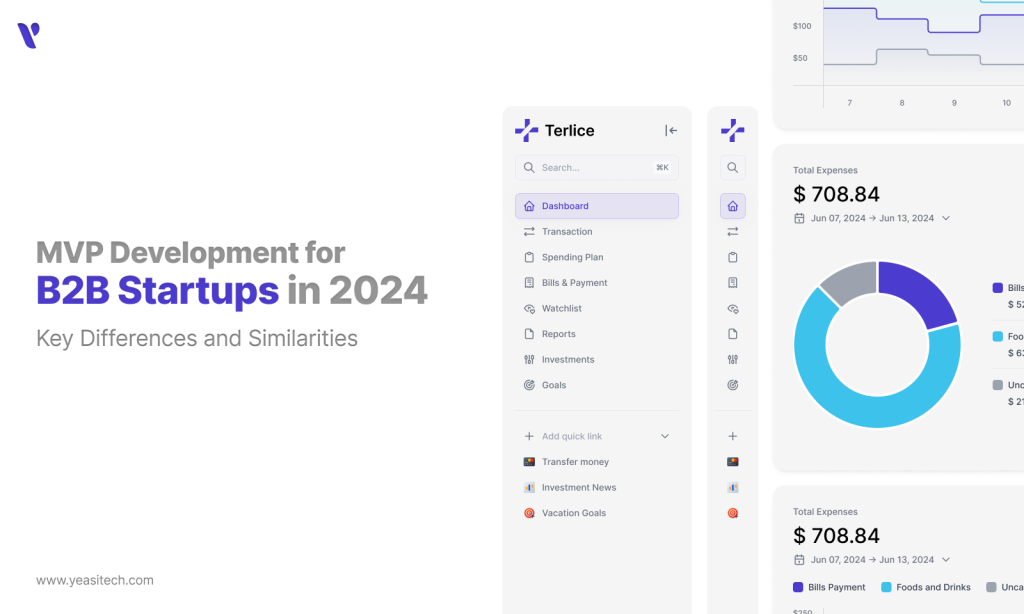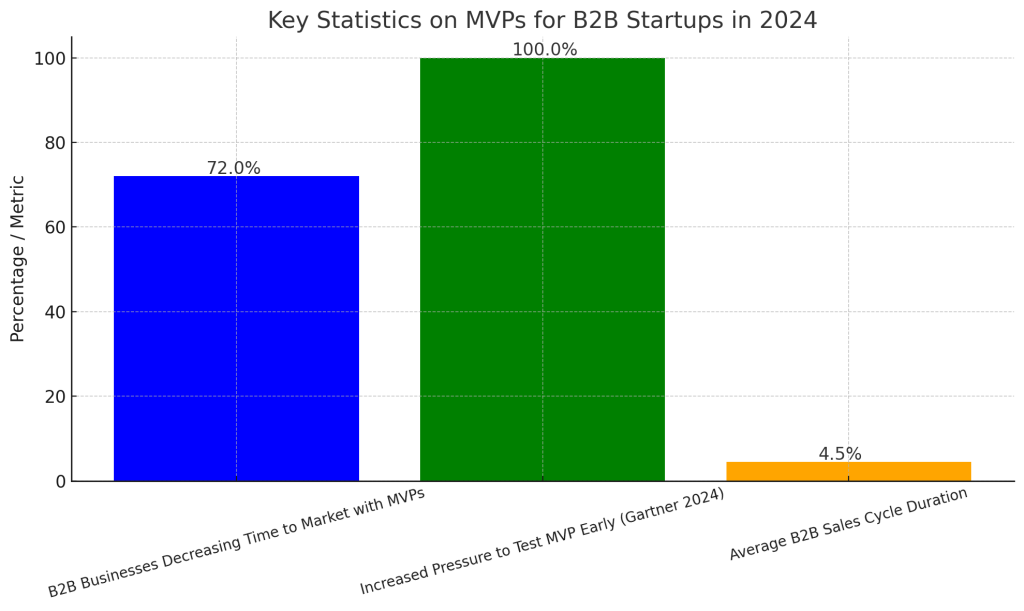MVP Development for B2B Startups: What’s Different and What Stays the Same in 2025

In the busy and competitive world of B2B startups, making a Minimum Viable Product (MVP) is not just about trying out an idea. It’s about showing that the idea can work as a business, reducing risks, and making sure it meets market needs in a fast and affordable way. In 2025, B2B startups need to be quick, research the market well, and focus on business goals to stand out and succeed.
This blog dives deep into what makes MVP development unique for B2B startups in 2025, covering strategies, insights, data, and real-world case studies to equip founders and product teams with the knowledge to make their MVP a success.
An MVP is a product’s most basic version, which only has the features that are absolutely necessary. A small group of early users, typically other companies or organizations, are contacted to test a business idea for B2B start-ups. Feedback is then gathered to develop the product.
Making a basic prototype is insufficient to create a business-to-business (B2B) Minimum Viable Product (MVP) in 2025. These days, entrepreneurs create MVPs that function in real-time, provide useful data, and are simple to scale. They use modern technologies like artificial intelligence (AI), big data, and machine learning to become more intelligent and effective.
Fun Fact: According to a 2025 Deloitte survey, 78% of startups using AI-driven MVPs reported faster time-to-market compared to traditional methods.
Read more about MVP, check out our blog on Why MVP Development is Crucial
The MVP process is an essential component of product testing in the business-to-business (B2B) sector. Solving actual problems is more important than having a lot of features. The goal of B2B success is to provide other companies with measurable, transparent outcomes; therefore, an MVP should focus on proving its worth.

In B2B MVP development, “business-first” means focusing on what the business needs before thinking about product features. In B2C, MVPs usually focus on making the user experience fun and engaging. But in B2B, the MVP should solve real problems that businesses in that industry face.
Example Case Study
The minimum viable product (MVP) of cloud-based accounting software FreshBooks was created to simplify invoicing for small businesses. FreshBooks attracted early users by concentrating on the major issue of challenging manual invoicing, and it soon gained popularity among companies trying to simplify their financial operations.
Emerging Trend (2025): Startups integrating compliance features within MVPs are 45% more likely to secure enterprise clients, as noted in a KPMG 2024 report
B2B clients demand products that justify their investments by delivering measurable returns. Whether through cost reduction, productivity gains, or time savings, the MVP should make it abundantly evident how it may yield a return on investment.
Fun Fact: A Gartner report shows that in 2024, half of B2B buyers look at a solution’s ROI as the main factor before making a purchase.
MVP development has changed in the modern day, with B2B startups developing and validating their products influenced by new technology, techniques, and customer expectations. Here are some shifts shaping MVP development in 2025:
B2B clients today expect data-backed solutions. MVPs must not only be capable of delivering value but should also incorporate data that drives insights and facilitates decision-making.
Real-World Example: Looker, a data visualization platform, released an MVP that focused primarily on offering business insights rather than extensive visualization features. Looker quickly gained clients who valued data-driven decisions by providing instant insights.
Impact: Looker’s quick expansion allowed it to add more features, and in 2019 Google purchased it for $2.6 billion.
According to a McKinsey report (2024), 65% of B2B customers expect personalized interactions throughout their journey. In response, B2B MVPs are adopting AI to deliver personalized user experiences even during the initial stages.
Case in Point: Salesforce Einstein initially launched as an MVP offering basic AI-driven insights. By targeting personalized engagement in CRM, Salesforce was able to validate its approach and later scale Einstein into a core feature that is now widely used by its enterprise clients.
The sooner B2B startups prove their MVP works, the quicker they can get funding or grow. In 2025, startups must show their MVP’s value within 90 days to catch the attention of investors.
Fun Fact: Did you know that companies starting in 2025 are taking 12% less time to develop their MVPs compared to five years ago? This speed is driven by a focus on core functionality, faster feedback loops, and iterative testing.
Let us read steps for a Business-First MVP Development Process in brief:
Finding unfulfilled needs and determining whether a product is a good fit for the market are two key objectives for market research. This involves investigating competitors, understanding the issues clients encounter, and determining the gaps in the solutions already in use.
When building an MVP, B2B startups should prioritize features that directly solve client problems. This could involve a basic feature set focusing on high-impact areas rather than a comprehensive tool with multiple functionalities.
Insight from Data: 83% of B2B customers in a recent survey preferred MVPs with fewer, well-developed features rather than a fully-fledged, complex tool with multiple incomplete features.
Pick key performance indicators (KPIs) that align with your business goals. These could be things like how many new customers you get, how much time you save, or how much money you save. Keeping track of these numbers will show you how well your MVP (minimum viable product) is doing and help you spot areas that need improvement.
Let us discuss popular real-life MVP Success Stories:
When Dropbox launched, it used an MVP video to illustrate its core functionality—file sharing and storage. This video was made for businesses, showing how simple and useful Dropbox is. It quickly caught the attention of companies looking for an easy way to manage their files.
Impact and Results: Dropbox’s first video got thousands of people to sign up, helping the company learn what users wanted and showing that people were excited about their product.
Intercom initially launched a basic MVP focused on real-time customer interaction for businesses. By concentrating on a single function, Intercom established a clear product vision and attracted early adopters among businesses seeking better ways to engage with customers.
Impact and Results: Intercom’s MVP allowed it to raise significant funding and expand its feature set based on real user feedback. Today, Intercom serves thousands of companies, emphasizing the value of a targeted MVP approach.
Zoom began as a simple app with just one main purpose—making reliable video calls. While other companies were adding many extra features to their video tools, Zoom focused on keeping things easy and ensuring that video calls were always smooth and dependable.
Impact and Results:
Zoom focused on what businesses needed most—reliable video calls—rather than adding extra features. This strategy worked well because companies cared more about stability than fancy add-ons. By making sure its service was dependable, Zoom quickly attracted big companies, which led to a massive rise in users. Its user base had increased to the point where it was the most popular option for business communication by 2020. Zoom is currently among the most widely used video platforms globally as a result of this continuous emphasis.
Statistic: 45% of businesses are more inclined to adopt an MVP if it includes robust security features.
To develop an effective MVP, B2B startups must avoid common pitfalls that can derail progress:
It might become more difficult to confirm fundamental assumptions and weaken the MVP’s focus if too many features are added. A single, high-value function that solves a particular customer pain point should be given priority by startups.
B2B security is important, particularly in regulated sectors like banking and healthcare. B2B MVPs that fail to incorporate security features face high turnover rates. MVPs with early security focus experience 50% lower churn among B2B clients.
If B2B startups want to create a successful MVP in 2025, they should focus on their main business goals. Instead of including too many features, they should focus on what their customers truly need. By listening to feedback and making improvements, startups can build MVPs that stand out in the market and help their business grow. The significance of understanding B2B dynamics is demonstrated by examples such as Dropbox and Intercom.
If you’re a startup looking for help in building your first product, working with experts like YeasiTech can make the process easier. They guide you step by step, helping you create a strong foundation for success in a competitive market.
Want more articles on MVP? We got you covered, check out our blog below on MVPs:
MVP development helps B2B startups quickly validate ideas, reduce risk, and align products with customer needs, leading to better outcomes and faster market entry.
In software development, MVP (Minimum Viable Product) is the simplest version of a product with just enough features to satisfy early users and gather feedback. It helps teams test ideas, validate market demand, and make improvements before full-scale development.
Successful B2B MVPs include core functionality addressing significant pain points, client feedback mechanisms, measurable outcomes, and scalability for future growth.
MVP development services build a basic product with key features to test market viability. It covers research, design, development, testing, and deployment, helping businesses validate ideas cost-effectively before a full-scale launch.
In Agile, an MVP (Minimum Viable Product) is a functional version with core features to validate ideas and gather user feedback for iterative improvement.
YeasiTech is a trusted IT service partner with 8+ years of experience, empowering 250+ businesses with scalable web, mobile and AI solutions.
Explore related topics to broaden your understanding and gain actionable insights that can transform your strategies.